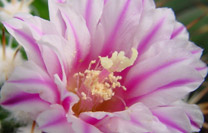 |
 |
|||||||||
 |
 |
|||||||||
|
|
Cacti belong to the dicotyls (two seed lobes) and this can be seen in
a germinating seedling which has two cotyledons opposite each other. Young
seedlings cannot withstand dry conditions. After a few weeks, they can
already be fairly drought-resistant, depending on the species. The young
seedling first develops a strong primary root which gradually becomes
narrower and gives off small lateral roots that collect the water and
nutrients. Cereus usually have a deep taproot whereas the Rebutia for
example has a more turnip-shaped root structure. The surface skin (epidermis)
of the cactus is meant to prevent evaporation. The outer layer is very
strong and covered with a thick layer of wax. A variety of spines can
be distinguished and these protect the plant from grazing animals, strong
sunlight, cold and evaporation. The spines are able to capture moisture.
The flowers vary considerably and their sizes range from a few millimetres
to about 40 cm. They are found in many colours, with the exception of
shades of blue.
|
||||||||||||||||||||
|
|||||||||||||||||||||